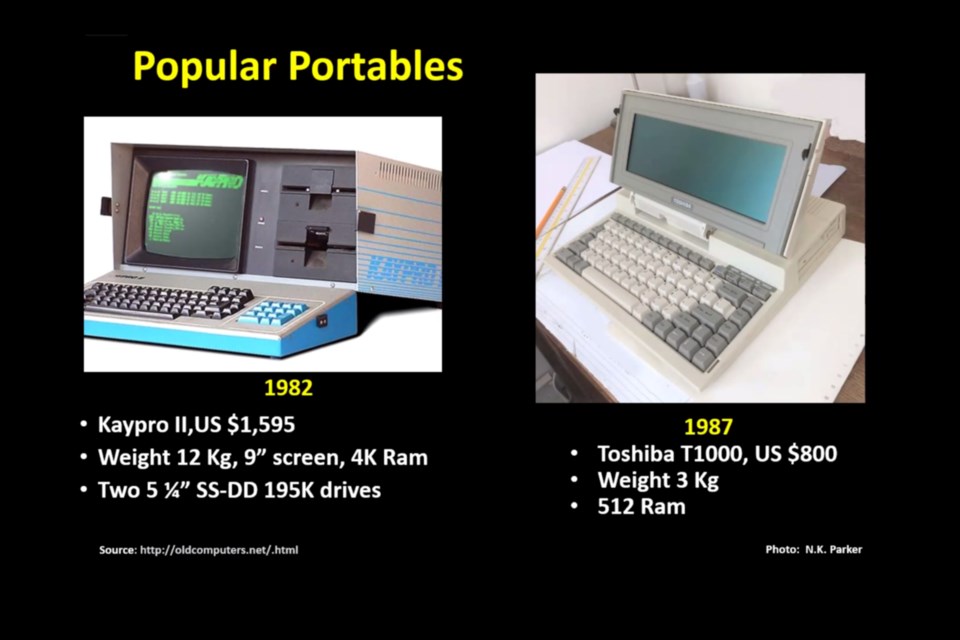ATHABASCA — It’s not exactly a chicken or egg scenario, but is Athabasca University's (AU) success as a world leader in distance education a result of the technology that has been developed over the years, or has AU's mandate to provide students with quality opportunities from a distance played its own role in how those technologies have developed?
Using the web-based Wayback Machine and personal experiences from working at AU, professor emeritus Robert Holmberg and independent researcher Nancy Parker gave a presentation March 24 for Science Outreach – Athabasca, starting with how courses used to be printed in-house, all the way to the development of MOOCs, massive online open courses, as well as taking courses normally instructed in-person and developing them successfully for online.
Holmberg started with AU when it was still based in Edmonton in 1974 and eventually moved to Athabasca where he retired in 2007. In that time, he developed 13 science courses and helped deliver 18. Parker was “pivotal” in AU’s quality assurance, accreditation initiatives, co-chaired the data standards integrity and security working group, among other achievements.
“I always find it useful to go over (words) and see what my definitions are compared to yourselves, and so technology is basically techniques and machines, and the techniques include procedures, methods, and software, and the machines are sometimes called hardware,” said Holmberg, “And in the case of this presentation, it means to record data or information to reproduce or duplicate that data and to transmit that data.”
There are two main advantages of having that data available — to increase productivity and monitor the progress of individuals, and to reduce costs, he said, and the disadvantages are high capital costs initially and how it dehumanizes interactions.
“Evolution is simply change over time and the forces for change or evolution within universities are both internal and external. So, internal are the people of the institution with their different backgrounds and ideas and ideals. They make policies (and) the policies drive the institution,” he said. “External includes governments of provincial and federal and they have policies and budgets that affect the university and then there's world external events and, for example, the economy and the price of oil affects universities.”
AU started long before it was built, Parker said.
“I'll start with 1967,” she said. “To put things in context Star Trek was on the television, the Beatles "Penny Lane" was on the radio, and it was Canada's centennial year. Times had changed. The province was coming of age with more urban than rural graduates, and Premier Ernest Manning recognized the need for change and this white paper indicated shift from developing infrastructure and resources to human development and it included the need for a fourth university to meet future demands for highly trained professionals.”
When AU finally started it had a small staff who had to figure out how to develop open courses allowing the student to enrol at any time in the year and jump into learning without missing anything.
“So, following the concepts of distance learning, openness and certain pedagogical theories the university, as Nancy said, had its emphasis on interdisciplinary studies,” Holmberg said. “It wanted to create modules of instruction without any prerequisites that could be taken in virtually any sequence, and this meant that the courses had to be developed from the ground up, from scratch, because most commercial materials would not fill the bill. And printed and audio-visual materials were to be developed in-house for efficiency and cost effectiveness.”
In those early days, before computers were commonplace, manuscripts were handwritten, typed out on an electric typewriter, revised, retyped, revised and retyped again until it was deemed ready.
“So, we had over 200 start dates for students, and they could work at their own pace and initially we had no deadlines, we figured adults would go through at their own pace. Well, we quickly found out with no deadlines, a lot of students did nothing,” said Holmberg.
Eventually a deadline of six months was set and accompanying the print material were presentations made via television and radio which eventually turned into recordings. Tutors were contacted by telephone.
By the 1990s, Parker said, there was more emphasis on two-way communication online and AU adopted different systems for its innovative online graduate programs.
“For students and tutors it's hard to overstate the importance of the shift to e-mails,” said Parker. “In the 1990s the number of staff using e-mail addresses was small enough ... that many of them just used their first name.”
And while the number of home computers owned by AU students was twice the national average, the technology to connect them via the Internet wasn’t quite there yet.
“Broadband is still very much an urban infrastructure and ... satellite connections are available for some but clearly not all remote communities,” she said. “The lack of reliable high-speed internet is a handicap for people who were forced to work from home.”
The full presentation can be seen at scienceoutreach.ab.ca.



